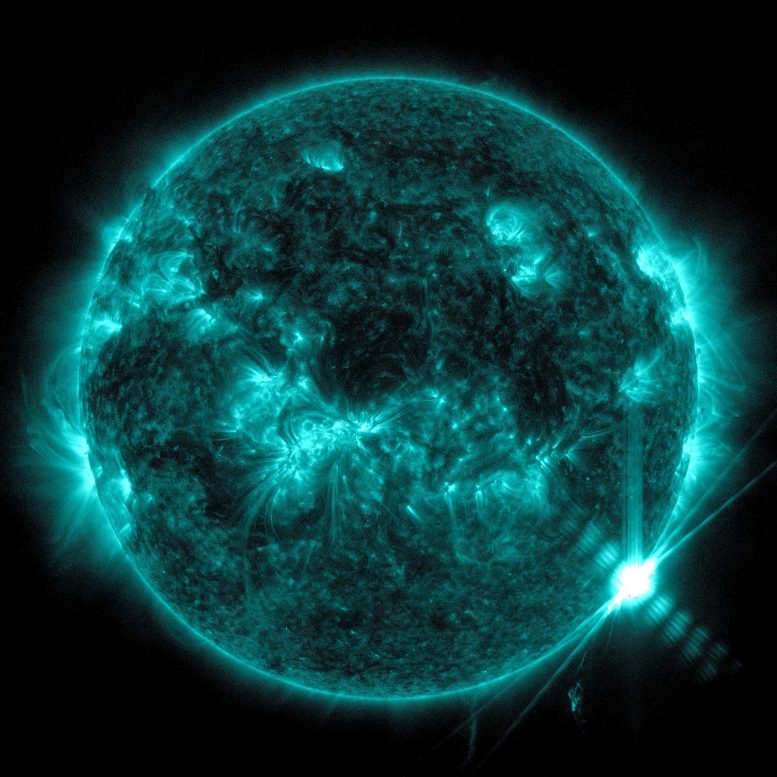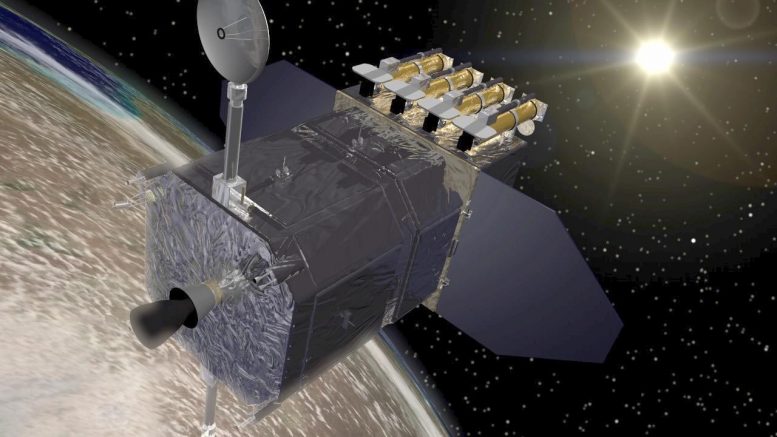
NASA’s Solar Dynamics Observatory captured this image of a solar flare – as seen in the bright flash on the lower right – on Feb. 9, 2024. The image shows a subset of extreme ultraviolet light that highlights the extremely hot material in flares, and which is colorized in teal. Credit: NASA/SDO
On February 9, 2024, at precisely 8:14 a.m. EST, the Sun unleashed a significant solar flare, an event meticulously captured by NASA’s Solar Dynamics Observatory (SDO). This particular flare has been classified as an X3.3, indicating a level of intensity that places it among the most powerful solar emissions. But what exactly are solar flares, and why is their monitoring important?
What Are Solar Flares?
Solar flares are sudden eruptions of energy on the sun’s surface. These phenomena are caused by the tangling, crossing, or reorganizing of magnetic field lines near sunspots. The released energy spans the entire electromagnetic spectrum, from radio waves to x-rays and gamma rays. Solar flares are classified according to their brightness in the x-ray wavelengths: X, M, C, B, and A, with X-class flares being the most intense. The numerical value following the class designation further refines its strength, with higher numbers indicating a more severe event. Thus, an X3.3 flare, such as the one observed on February 9, 2024, represents a substantial release of solar energy.
Impact on Earth
The effects of solar flares on Earth can vary. While flares themselves primarily emit electromagnetic radiation, it is often the associated coronal mass ejections (CMEs) that can have tangible impacts on Earth. These massive bursts of solar wind and magnetic fields can reach Earth in one to three days, potentially leading to geomagnetic storms. These storms can disrupt satellite operations, telecommunications, navigation systems, and even power grids in extreme cases. Additionally, solar flares and CMEs can enhance the Earth’s auroras, creating spectacular natural light shows near the poles.

Artist’s concept of the Solar Dynamics Observatory (SDO). Credit: NASA/Goddard Space Flight Center Conceptual Image Lab
NASA’s Solar Dynamics Observatory
NASA’s Solar Dynamics Observatory plays a crucial role in monitoring and studying solar activity. Launched on February 11, 2010, the SDO is part of NASA’s Living With a Star (LWS) program, designed to understand the causes of solar variability and its impacts on Earth. The observatory provides near-real-time imagery of the sun across multiple wavelengths, offering invaluable data on solar flares, sunspots, and other solar phenomena. The SDO’s ability to continuously observe the sun in high definition allows scientists to study the solar atmosphere in unprecedented detail, aiding in the prediction of space weather events that could affect Earth.
Conclusion
The recent X3.3 solar flare captured by the SDO underscores the dynamic and powerful nature of our sun. While solar flares are common occurrences in the sun’s life cycle, their study is crucial for understanding and mitigating their potential impacts on modern technology and communication systems. Through the diligent work of observatories like the SDO, humanity can better prepare for and navigate the challenges posed by space weather, safeguarding our technological infrastructure and ensuring a more resilient society against the whims of our star.









Can’t wait to see the world “prepare” for the mini-nova many astro scientists believe is on the cards. Funny politicians and the media are staying schtum about such an event – which, whenever it comes, will make the climate “apocalypse” look like a walk in the park.